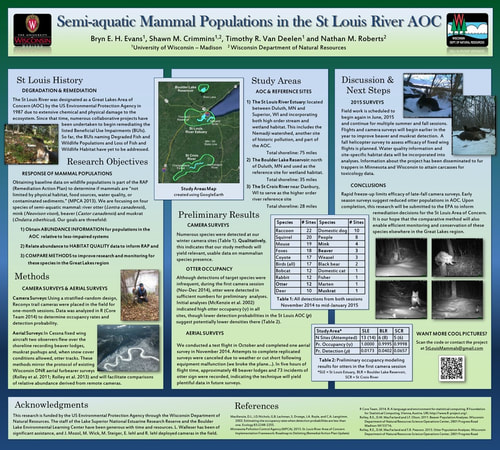Recovery of semi-aquatic mammals in the St. Louis River Area of Concern
|
|
Advisors: Dr. Tim Van Deelen, UW-Madison
and Dr. Shawn Crimmins, UW-Stevens Point Committee: Dr. Nathan Roberts, Wisconsin DNR and Dr. Benjamin Zuckerberg, UW-Madison My master thesis focused on the status of semi-aquatic mammal populations in the St Louis River Area of Concern. The project is a collaborative effort of the Wisconsin Department of Natural Resources, the Minnesota Pollution Control Agency, and the University of Wisconsin, as well as the Lake Superior National Estuary Research Reserve, Fond du Lac Indian Tribe, and the St Louis River Alliance. We conducted trail camera and small plane surveys to obtain detection histories for beavers, river otters, muskrats, and mink. Surveys have been completed through out the AOC as well as in two reference sites, and analyzed these data with occupancy models incorporating habitat covariates to help inform the EPA's decision regarding the recovery of wildlife populations. |
 Awarded best graduate student poster at TWS Minnesota Wisconsin joint chapter meeting February 2015
Awarded best graduate student poster at TWS Minnesota Wisconsin joint chapter meeting February 2015
History
Due to historical human development, disturbance and pollution, the St Louis River estuary has experienced a reduced capacity to support native wildlife. The St Louis River Area of Concern has both the “Degraded Fish and Wildlife Populations” and “Loss of Fish and Wildlife Habitat” Beneficial Use Impairments (BUIs). A significant data gap in mammal population information was identified by the Stage One Remedial Action Plan for the St Louis River (MPCA and WDNR, 1992). A few statewide surveys can provide some insight on historic semi-aquatic mammal populations (Kohn and Ashbrenner 1984; Ensor et al 1993), but no work has been conducted to date to survey or document presence or absence of semi-aquatic mammal species in the St Louis River estuary or Nemadji River watershed.
Since designation as an Area of Concern, remediation and restoration efforts have been underway to improve conditions in the estuary. However, before conclusions can be drawn on the success of these projects, objective data on the status of wildlife populations in the area must be obtained. A survey of semi-aquatic mammal species is listed as a priority management action for delisting under the Degraded Fish and Wildlife Populations BUI in the 2013 Remedial Action Plan Update (MPCA, 2013).
Methods
We used both remote camera surveys and aerial surveys to obtain data on river otter (Lutra canadensis), mink (Neogale vison), beaver (Castor canadensis) and muskrat (Ondatra zibethicus) presence in three aquatic systems. The preliminary field season (November 2014 to January 2015) yielded useful data for otter occupancy, but indicated that adjusting survey timing for earlier in the fall season would be beneficial. From summer 2015 to early spring 2016 we monitored additional camera sites and completed several fixed wing and one helicopter aerial survey.
Due to historical human development, disturbance and pollution, the St Louis River estuary has experienced a reduced capacity to support native wildlife. The St Louis River Area of Concern has both the “Degraded Fish and Wildlife Populations” and “Loss of Fish and Wildlife Habitat” Beneficial Use Impairments (BUIs). A significant data gap in mammal population information was identified by the Stage One Remedial Action Plan for the St Louis River (MPCA and WDNR, 1992). A few statewide surveys can provide some insight on historic semi-aquatic mammal populations (Kohn and Ashbrenner 1984; Ensor et al 1993), but no work has been conducted to date to survey or document presence or absence of semi-aquatic mammal species in the St Louis River estuary or Nemadji River watershed.
Since designation as an Area of Concern, remediation and restoration efforts have been underway to improve conditions in the estuary. However, before conclusions can be drawn on the success of these projects, objective data on the status of wildlife populations in the area must be obtained. A survey of semi-aquatic mammal species is listed as a priority management action for delisting under the Degraded Fish and Wildlife Populations BUI in the 2013 Remedial Action Plan Update (MPCA, 2013).
Methods
We used both remote camera surveys and aerial surveys to obtain data on river otter (Lutra canadensis), mink (Neogale vison), beaver (Castor canadensis) and muskrat (Ondatra zibethicus) presence in three aquatic systems. The preliminary field season (November 2014 to January 2015) yielded useful data for otter occupancy, but indicated that adjusting survey timing for earlier in the fall season would be beneficial. From summer 2015 to early spring 2016 we monitored additional camera sites and completed several fixed wing and one helicopter aerial survey.
References
Ensor, K.L., W.C. Pitt and D.D. Helwig. 1993. Contaminants in Minnesota Wildlife. Minnesota Pollution Control Agency Water Quality
Division, 520 Lafayette Road, St. Paul MN 55155.
Kohn, B.E. and J.E. Ashbrenner.1984. Wisconsin Department of Natural Resources Research Report #129. December 1984, Dept. of Natural Resources Technical Library, 3911 Fish Hatchery Road, Fitchburg WI 53711
Minnesota Pollution Control Agency (MPCA). 2013. St Louis River Area of Concern Implementation Framework: Roadmap to Delisting (Remedial Action Plan Update), By LimnoTech. St Paul, Minnesota. July 15, 2013. (http://www.pca.state.mn.us/index.php/view-document.html?gid=19677)
Ensor, K.L., W.C. Pitt and D.D. Helwig. 1993. Contaminants in Minnesota Wildlife. Minnesota Pollution Control Agency Water Quality
Division, 520 Lafayette Road, St. Paul MN 55155.
Kohn, B.E. and J.E. Ashbrenner.1984. Wisconsin Department of Natural Resources Research Report #129. December 1984, Dept. of Natural Resources Technical Library, 3911 Fish Hatchery Road, Fitchburg WI 53711
Minnesota Pollution Control Agency (MPCA). 2013. St Louis River Area of Concern Implementation Framework: Roadmap to Delisting (Remedial Action Plan Update), By LimnoTech. St Paul, Minnesota. July 15, 2013. (http://www.pca.state.mn.us/index.php/view-document.html?gid=19677)
